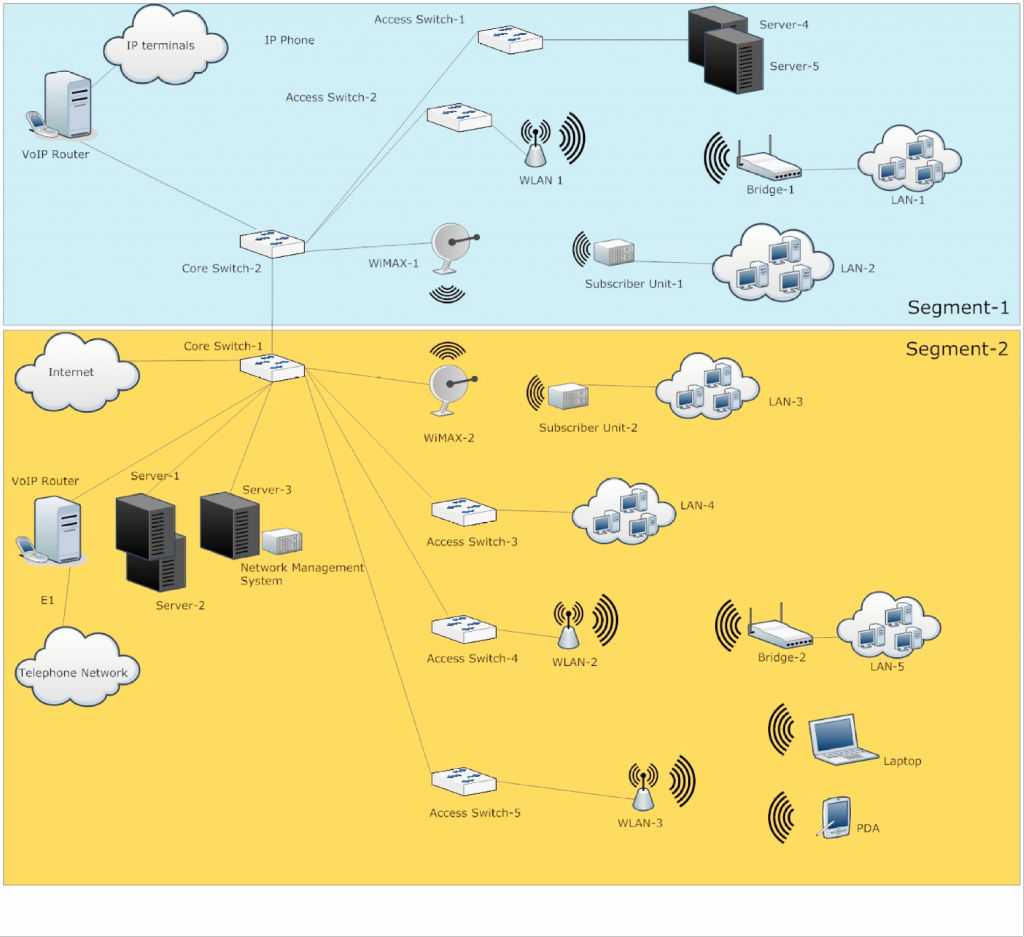General Tesbed/Platform Description
The University of Piraeus Research Center’s (UPRC) networking testbed incorporates a variety of hardware infrastructure and more specifically 5 WLAN Access Points, 2 WiMAX base stations, 10 laptops and 5 PDAs that can be used as mobile terminals, as well as 2 core and 5 access switches among with 2 servers and 23 PCs. The UPRC testbed also includes several software blocks that are related to the cognitive management of network elements and terminals, traffic generation, network simulation, collection and analysis of measurements, context monitoring and application provisioning. The aforementioned hardware and software can support the execution of a great variety of scenarios and use cases and moreover they are facilitating the integration of new hardware or software functionalities that are developed in the context of prototyping activities. The UPRC testbed is intrinsically flexible and extendable, based on a middleware platform that enables the integration, interaction and cooperation of all the entities that reside in it. The platform offers high-level interfaces with various interconnection ways, enabling experimentation with different problem handling practices, varied hardware and software configurations or even diverse architecture designs. The performance of validation procedures within the UPRC testbed and the collection of results are also possible, while it is possible to make the final experimentation environment much broader and larger in scale through the linking of this testbed with other already established European and international testbeds and experimental facilities.
In the figure below there is a graphical representation of the UPRC testbed:
Hardware Description
The basic hardware components of the UPRC testbed are the following:
- 2 CISCO Catalyst 3750 Core switches,
- 5 CISCO Catalyst 3560 Access switches,
- 2 HP ML350T05 servers,
- 2 CISCO 2811 VoIP gateways,
- 1 Network Management System running the HP NNM (Network Node Manager),
- 5 CISCO ASA 5505 Firewalls,
- 5 CISCO AIR-AP1131AG WLAN Access Points,
- 2 CISCO AIR-AP1242G WLAN bridges,
- 2 PROXIM Tsunami WiMAX base stations,
- 2 PROXIM Tsunami WiMAX subscriber units,
- 23 HP Compaq dc7900 PCs,
- 10 HP EliteBook 6930p Laptops,
- 5 HP IPAQ DATA MESSENGER PDAs with GPS, 3G, EDGE, GPRS, WLAN and Bluetooth support,
- 2 Nokia n810 Tablet PCs with WLAN, Bluetooth and GPS support,
- 1 Huawei 3G modem with GPRS, EDGE, UMTS and HSPA support.
Software Description
The basic management/simulation software components of the UPRC testbed are the following:
- Cognitive AP (CAP) agents,
- Cognitive Reconfigurable Device (CRD) agents,
- Cognitive Network Management System (CNMS) agents,
- Proprietary Network Simulator,
- OPNET,
- Omnet++,
- NS2,
- Apache web server,
- IBM ILOG optimization engine,
- HP OpenView management software.
Experimental/Prototyping Activities and Future Actions
The first version of the prototyping environment able to integrate sophisticated management functionalities was developed in the context of E2RII research project [i]. This has been then evolved to the E3 project’s [ii] prototyping environment for cognitive wireless B3G infrastructures, which encompasses several entities with self-x capabilities, supports autonomic terminal operation, includes traffic generators and cooperates with network simulators (such as NS [iii] and Omnet++ [iv]) for the execution of interesting use case scenarios. Software development in this environment is based on the Java based JADE/JADEX middleware platform, which facilitates significantly all the integration activities.
The UPRC testbed has been developed based on open source and standardized solutions such as Java, XML, FIPA-OS etc. All the interfaces between the various entities are open and have been implemented as intelligent agents, based on the JADE/JADEX platform. A suitable ontology that supports the exchange of information between the agents has been also defined and it is publicly available. There are open interfaces for the communication between the Cognitive Network Management System (CNMS) and the Cognitive Access Points (CAP) or the Cognitive Reconfigurable Devices (CRD), between the CAPs and the CDRs, as well as between CRDs. These interfaces allow, among others, the dynamic addition of new entities into the environment, as well as the dynamic removal of existing ones.
We plan to extend the aforementioned environment by further developing the included traffic models, mobility patterns and management functionalities in order to establish a substantial emulation environment over real networks (i.e. Ethernet, WLAN, WiMAX, UMTS) and using various hardware resources (i.e. core/access switches, WLAN/WiMAX access points, servers, laptops, PDAs), opening the way for large-scale real-world experiments for the FI.
The main goal is to develop a testbed consisted of hardware and software entities that will provide a distributed experimentation environment with several inherent capabilities such as guaranteed exchange of messages, a directory service, support of autonomic operation, etc. The testbed will allow the execution of a variety of actions, targeting to the validation and assessment of the management concepts for the Future Internet. The testbed will also support experimentation even from the initial stages of the research, providing valuable feedback to the study of the problems and the implementation of the solutions, allowing also the refinement and fine-tuning of the developed algorithms and functionalities.

